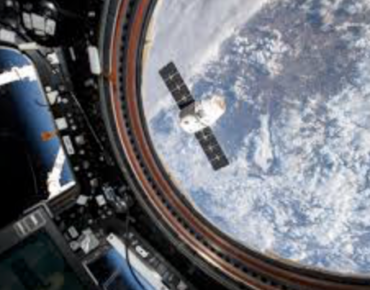Servers in Orbit, Datacenters Not Far Behind

Source: NASA
The International Space Station shines a little brighter in the night sky thanks to what amounts to an orbiting supercomputer lofted to the outpost last year as part of a year-long experiment to determine if high-end commercial computers can survive a trip to Mars.
The NASA upgrade to the space station’s number-crunching capability also is part of a steady shift in datacenter architectures gradually moving from land to sea and, eventually, Earth orbit, proponents say.
Among the supplies hauled to the space station during a resupply mission last August aboard a SpaceX Dragon cargo ship was a high-performance computing platform. Hewlett Packard Enterprise (NYSE: HPE) supplied its Apollo 40 family of servers running Intel (NASDAQ: INTC) two-socket Xeon processors with a 56-gigabit per second interconnect.
The delivery was part of a collaboration between the space agency and HPE to determine whether commercial computers can be launched into space and survive a proposed year-long flight to Mars, according to Mark Fernandez, the HPC technology officer at HPE and an investigator on the space-based computer experiment. One month after the SpaceX resupply mission to the space station, HPE reported its space-based computer had been powered up and delivered 1 teraflop performance in benchmark testing.
“We need to know if our computers can survive the trip” to Mars “and if they do survive the trip will they function properly,” Fernandez explained in an interview. “And if they are functioning properly, will they give the right answers?”
Launched last August, HPE's Spaceborne computer had completed 4,492 orbits (see below image) as of Tuesday (June 19) and has been functioning, as NASA would say, “nominally”. Meanwhile, two onboard servers are meant to mirror servers at NASA’s Ames Research Center that handle much of the processing required to support the space station. Fernandez said one server is being run as fast as possible while the second runs slower. “If an anomaly occurs and it only occurs on the fast one, [then operators] can slow things down.”
Adds Fernandez, “It’s better to run slow than to not run at all.”
The current schedule calls for the HPE servers to be returned to earth in November. The company would then conduct a failure analysis on components to determine how they “aged” after a year in space, Fernandez said.
The space-based computing initiative with NASA was launched in 2014 by long-time NASA supplier SGI, acquired by HPE in 2016.
The orbiting supercomputer is another example of how commercial technologies can now be used for “rugged” applications in space and other hostile environments. NASA mission rules require that laptops and other devices flown in space must be radiation-hardened, that is, able to withstand the blasts of ionizing solar radiation that can fry internal electronic components.
The traditional approach to hardening spacecraft electronics involves either backup circuits or using insulating substrates on commercial semiconductor wafers. That brute force approach is expensive. HPE engineers came up with what they say is a cheaper approach for hardening electronics: Company scientists reasoned “that simply slowing down a system in adverse conditions can avoid glitches and keep the computer running,” according to an HPE blog post.
The company also notes that current commercial electronic components far exceed radiation hardening requirements for the space station.
Key components for future space computing platforms and, perhaps, orbiting datacenters, are expected to be available in the next few years. For example, the space agency expects its next general-purpose processor, a variant of the ARM Cortex-A53 to be cleared for launch in 2020.
Meanwhile, space-based datacenters are moving closer to launch as a handful of startups develop architectures for securing orbiting datacenters. Partners Cloud Constellation Corp. and TokenEx are jointly designing a data security framework for a satellite-based datacenter that would layer secure storage and a security approach called tokenization used to protect sensitive data via tokens that serve as equivalents to data components.
The partners said their approach combines a data protection platform with a satellite network for data management the partners said would allow users to secure sensitive data in space while storing tokens at ground stations.
--Managing Editor Doug Black contributed to this report.
Related
George Leopold has written about science and technology for more than 30 years, focusing on electronics and aerospace technology. He previously served as executive editor of Electronic Engineering Times. Leopold is the author of "Calculated Risk: The Supersonic Life and Times of Gus Grissom" (Purdue University Press, 2016).













